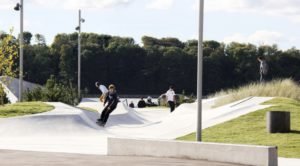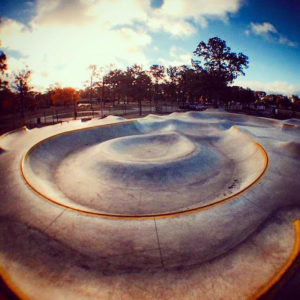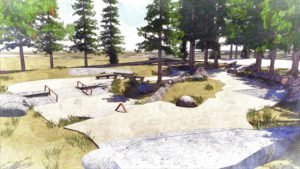By TESHA M. CHRISTENSEN
Ask a Minneapolis skater what he or she thinks of the city’s skate parks, and you’ll likely get a list of problems.
The six existing parks were built 15 years ago with modular obstacles and features that were designed by playground manufactures versus skateboard professionals. The park at Morris has a soft, asphalt surface and the ramps and features have sunk into it. All the existing skate parks are small and undersized. The elements are short, and not exciting to use. And they’re all falling apart.
These issues and more are outlined in the Minneapolis Parks and Recreation’s new Skate Park Activity Plan, which was initiated in 2012.
“Minneapolis skateboarders have been asking for quality skateboard parks for years. It has been a long five years in the making, but I am looking forward to the Minneapolis skateboard community finally getting the world-class skate parks they deserve,” stated City of Skate President Paul Forsline, who served on the MPRB’s steering committee for the new skate park plan.
Public comment on the plan was accepted online until Nov. 5, and will be taken in person during a public hearing on Wed., Nov. 29, 6pm, at the Minneapolis Parks and Recreation (MPRB) Headquarters, 2117 W. River Rd.
20-year roadmap
The 66-page Skate Park Activity Plan is a 20-year roadmap for providing quality support to the local skate park community and encouraging skating among new generations of park users.
The draft Minneapolis Skate Park Activity Plan has three goals:
1) Increase the number, variety, and distribution of skate parks in Minneapolis;
2) Address policy barriers to high-quality skate park experiences; and
3) Improve the overall skate park experience through design, operations, partnerships and safety measures.
It also provides context and analysis to help inform future decision-making regarding skate park opportunities within Minneapolis and the Minneapolis park system.
 Photo right: In this design conception, a skate park is shown at Nokomis as part of the Nokomis-Hiawatha Regional Park Master Plan. But, it is currently unfunded. It would be located west of the recreation center, and the initial design integrates natural elements. Skate bowls flow within the landscape. The skate plaza replicates nature with granite, bark textures, and shade trees. Plus, there’s a high priority on integrating water management features. (Image provided)
Photo right: In this design conception, a skate park is shown at Nokomis as part of the Nokomis-Hiawatha Regional Park Master Plan. But, it is currently unfunded. It would be located west of the recreation center, and the initial design integrates natural elements. Skate bowls flow within the landscape. The skate plaza replicates nature with granite, bark textures, and shade trees. Plus, there’s a high priority on integrating water management features. (Image provided)
The plan recommends having one regional skate park, ten neighborhood skate parks (including expansion of the existing six), and six skate spots for a total of 17 public skate parks.
“If the skate park plan is funded moving forward, it will give our award-winning Minneapolis Park system a skate park infrastructure second to none,” observed Forsline.
He pointed out that Minneapolis has developed some of the best skateboarders in the world, despite little public support. “We saw Alec Majerus take silver in July at the 2017 X Games at US Bank Stadium. Minneapolis skateboarding is known and respected worldwide,” said Forsline. “It is time for our own public entities to recognize this and support our local skate scene.”
What the parks could be
Currently, 5,000-square-foot skate parks exist at Morris, Armatage, Brackett, Elliot, Bottineau and Creekview parks.
“These six parks never inspired skateboards, yet some of the skate parks are the busiest features in their respective parks,” remarked Forsline.
 Photo left: The skate park at Morris Park. “Morris has limited space, so it would be important to prioritize a skate park for beginner and younger skaters, but have some creative and unusual features to still challenge more advanced skates,” remarked Paul Forsline of City of Skate. (Photo provided)
Photo left: The skate park at Morris Park. “Morris has limited space, so it would be important to prioritize a skate park for beginner and younger skaters, but have some creative and unusual features to still challenge more advanced skates,” remarked Paul Forsline of City of Skate. (Photo provided)
In the plan, these parks would be updated and expanded, when possible.
“Morris has limited space, so it would be important to prioritize a skate park for beginner and younger skaters, but have some creative and unusual features to still challenge more advanced skaters,” said Forsline. “A community stage would be a nice multi-use feature to include in this skate park space.”
“The skate park in Morris is in poor shape,” observed Longfellow resident Bill Welk. “I have not been there for several years due to the condition of the skate park and overall poor layout. The skate park features pre-fabricated concrete obstacles sat on an asphalt surface. Over time the heavy concrete obstacles have sunk into the asphalt and created gaps between the ramps and the asphalt. Not to mention that the rough asphalt eats up speed as a skateboarder pushes across; however, the aged asphalt is wonderful at removing layers of epidermis should a trick not go according to plan.”
Brackett’s existing skate park has always been a well-used skate park, despite having a rough asphalt surface. “With more space allocated here, having both street and transition skateboard features would be important,” said Forsline. “We have to keep the existing old playground rocket feature as a landmark. Maybe build the skate park around the rocket? A NASA and/or space themed skate park would be cool. A glowing skateable moonscape would be awesome.”
To accommodate the number of skaters in the city, the plan calls for adding skate parks at Nokomis, Northeast Athletic Field Park, Central Gym Park, and Cedar Field Park, and the potential Underpass Park and Skyway Commons Pocket Park.
A skate park at Nokomis is a part of the Nokomis-Hiawatha Regional Park Master Plan, but it is currently underfunded. It would be located to the west of the recreation center, and the initial design integrates natural elements. Skate bowls flow within the landscape. A skate plaza replicates nature with granite, bark textures, and shade trees. Plus there’s a high priority on integrating water management features.
 Photo right: “The Nokomis Park is in a great location. It is set to be built in an area between the two lakes,” pointed out Longfellow resident Bill Welk of City of Skate. (Illustration courtesy of City of Skate)
Photo right: “The Nokomis Park is in a great location. It is set to be built in an area between the two lakes,” pointed out Longfellow resident Bill Welk of City of Skate. (Illustration courtesy of City of Skate)
“The Nokomis Park is in a great location. It is set to be built in an area between the two lakes,” pointed out Welk.
In addition to creating spaces for skateboarders, planners recognize that inline skaters and BMX riders will use these parks.
“The skateboarding community in Minneapolis is pretty tight-knit,” observed Welk. “I like that skateboarding is always there for me when I want it. I can go skate by myself or with a group of people. There isn’t a set time, a season, or reliance on another people to skateboard.”
The challenges the community faces include a lack of public parks and long winters, according to Welk, who was part of the steering committee meeting on the Skate Park Activity Plan.
Quality skate parks: a great asset
“Skateboarding is only going to grow in popularity, and a city with a skateboarding plan is going to benefit,” pointed out Forsline, whose children skateboard. “Quality built skate parks by our park system will be the most heavily used features in our park system, and will, therefore, be a great value for our tax dollars. Well-designed skate parks should be inspired spaces that the community and skaters are both proud of.
“I hope every Minneapolis child has the opportunity to discover the challenge and creativity of skateboarding at their local public park and throughout our city.”
Comments
No comments on this item Please log in to comment by clicking here